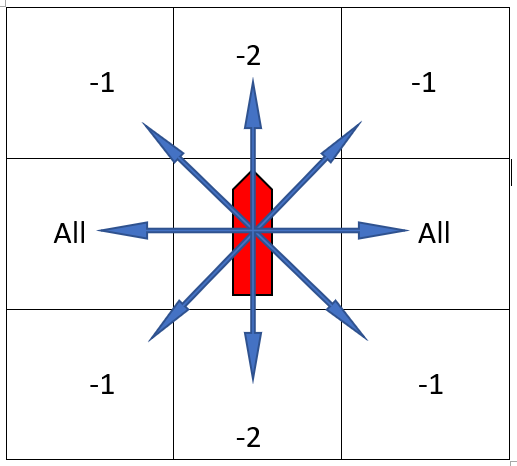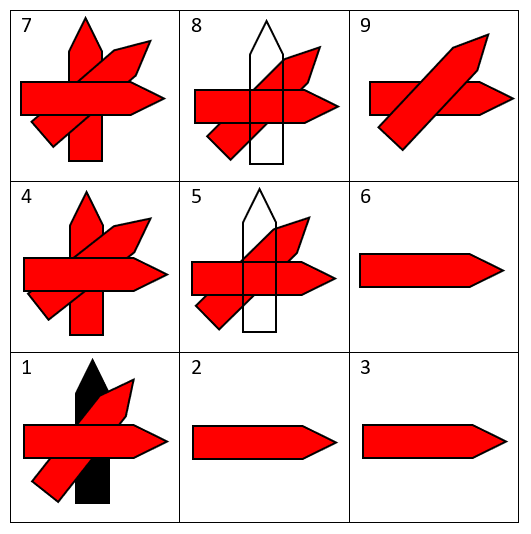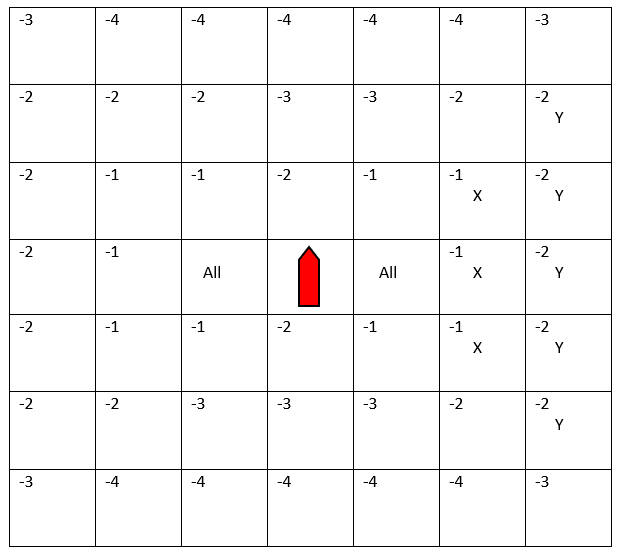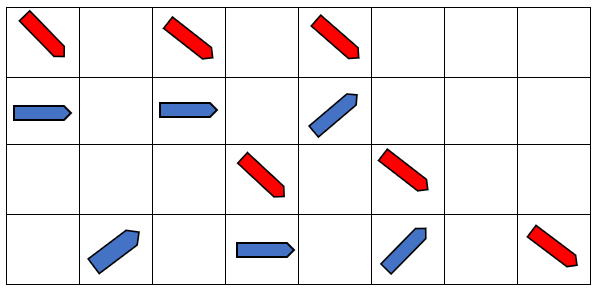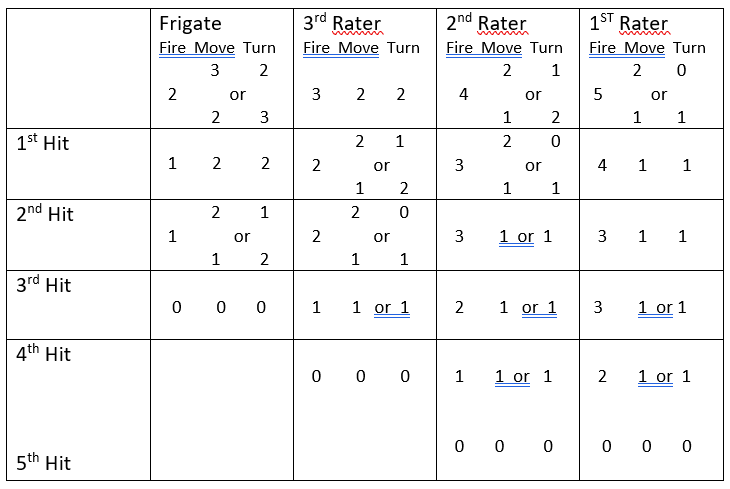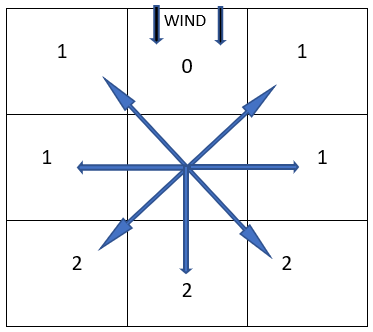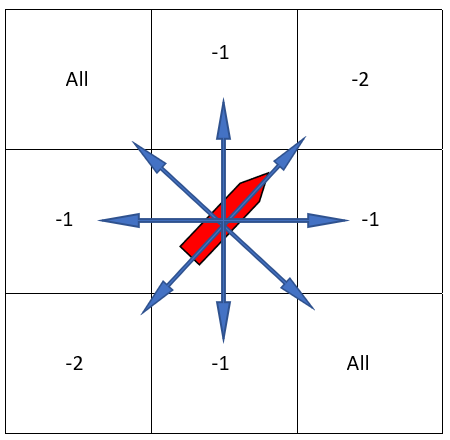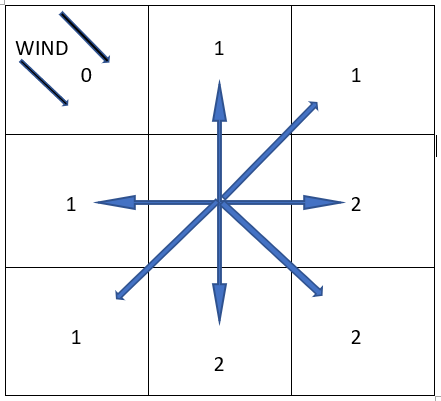Square Rigger Chess models the manoeuvre and combat of square rigged naval ships of the Napoleonic period. No element of chance enters into this system, the results depend entirely on player skill and the chosen starting conditions, to this extent it functions as a chess-like game. This modelling system depends on several simplifications for game play: -
The division of sea areas into squares. The orientation of all ships and firepower and wind direction, in just 8 possible directions. The characterisation of ships by just 3 factors, Firepower, Speed, and Turning ability. F, S, and T.
Firepower. – (the combined effects of cannon + carronades + mortars + musketry), ships begin with a firepower factor of 2, 3, 4, or 5. In attack a ship may allocate its firepower factor in any directions preferred up to the maximum of its firepower as shown in the Fire chart following: For example, a 2Nd Rater with a firepower of 4 could direct all its firepower of 4 in a starboard (right) or port (left) broadside, but not both. It can only use a maximum of 2 units of its firepower (4 – 2 = 2) fore or aft and only a maximum of 3 units (4 – 1 = 3) off the port or starboard bows or off the port or starboard stern, thus it could for example simultaneously fire 2 units of its firepower fore and the other two off the starboard bow, (or any other direction chosen). In combat the attacker assigns firepower factors to chosen directions first.
The effect of attacking firepower falls off with distance, by 1 per every square after the immediately adjacent square effect shown below. (See the Distance Fire Chart later.)
Ships defending against Fire use their Firepower factor in the same way, assigning part or all of it to various directions to try to cancel the effects of incoming fire, however it does not decrease with distance. This curious seeming rule reflects the fact that the vulnerability of ships rose in precisely those directions where they could use the least of their firepower.
Any ship which receives from any direction more firepower than it assigns to that direction takes one ‘Hit’ for every unit of firepower that it loses by. Merchant ships have defensive ‘firepower’ only.
Speed and Turn. In a player turn ships may move one square forward for every Speed factor they have and may turn 45 degrees (one eighth of a full circle) for every Turn factor they have.
The chart below shows what manoeuvres a 3rd Rater with a Speed of 2 and a Turn of 2 can do in a move with mainly starboard turns.
The nimble 3rd Rater starts on square 1, its initial position shown in black. It can end its move in any of the positions shown by red ships by using some or all of its 2 Speed and 2 Turn capabilities. Note that it could also use turns to port instead of starboard to end up in the positions and orientations shown by the white ships and that it could also make other orientations on squares 4 or 7 using turns to port. (Not shown).
The heavier ships have less manoeuvrability than a 3rd Rater, and manoeuvrability declines as ships take Hits (see damage chart).
Wind direction and intensity also affect manoeuvrability (see wind rules and chart).
Ship Classes.
First Raters. F5, S1, T1. These rare lumbering behemoths with 100+ guns have huge firepower but poor speed and manoeuvrability.
Second Raters. F4, S1, T2. As above but these monsters with 84 guns do manoeuvre slightly better.
Third Raters. F3, S2, T2. These faster and more manoeuvrable 64-gun warships serve as the main workhorses of the line of battle.
Frigates. F2, S2, T3. These fast and highly manoeuvrable 44-gun warships can bring vital extra fire support when heavier ships engage.
Distance Fire Chart.
Firepower has its greatest effect into adjacent squares, but ships may also use their firepower at greater distances. Basically, subtract one from the effect of assigned firepower for each additional square. Thus, if the vessel below has a firepower of 4 and assigns it all to a starboard broadside that broadside can only have an effect of 3 on any one square marked X, or 2 on any one square marked Y.
The Non-Adjacency Rule. Ships on the same side must leave at least one empty square (orthogonally or diagonally) between themselves when ending their player moves.
This rule may seem slightly unrealistic, although friendly ships did try to keep at least a ships length between themselves.
This rule allows for the use of the classic manoeuvre of ‘cutting the line’ without the complications of modelling collisions. Ships on opposite sides can occupy adjacent squares, and they will often do so to disrupt enemy formations and to direct the fire of several ships to a single target.
The above chart shows a flotilla of red ships engaging a flotilla of blue ships. Note that whilst several ships from either side have moved to squares adjacent to enemy ships, no two ships on the same side lie orthogonally or diagonally adjacent to each other.
The non-adjacency rule does not apply inside of harbours, friendly ships may moor and manoeuvre alongside each othear, ships may also lay adjacent to friendly ships that have struck their colours.
Damage Chart. As ships take Hits, their Firepower, Speed, and Turning abilities decline as shown on the following chart. Players should place damage markers on their ship markers as appropriate to show their status.
Any ship reduced to 0 0 0 ‘Strikes its Colours’ and remains immobile and inactive for the rest of the battle and subject to towing away for repairs or as a prize afterwards, if the victor has a mobile ship spare to do this, otherwise the victor may elect to scuttle it.
Wind Chart. Players set the wind direction and intensity before play, the wind can come from any one of 8 directions. Players may also make some provision for a change of wind during the game if desired.
Moderate Wind simply prevents movement directly into the wind (square riggers could not do this), however they can turn into the wind and then turn to 45 degrees to the wind and effectively tack in a zig zag in a generally windward direction.
Stronger winds also deny movement directly into the wind and additionally allow for greater movement with the wind as shown in the chart below. The numbers on the squares represent the number of squares a ship can move in that direction for the expenditure of a single speed point. Ships can move twice as far with a following stronger wind.
General notes on scenarios and tactics. Players should practice with small numbers of ships at first. Larger flotillas and fleets may require the command of several Commodores or Admirals each in charge of a squadron, as coordinating the movement and fire of many ships becomes a challenging task.
Scenarios can include convoy interception (see note on transports and merchant ships), chasing down and capture of slow enemy heavy ships by more numerous lighter ships, harbour blockades and attempted breakouts, and fleet battles for naval supremacy.
Transports and Merchant Ships usually effectively consist of unarmed versions of naval ships, with the heavier ones having less speed and manoeuvrability. They take damage and strike colours in the same fashion.
Play takes place by alternate moves. In each player move players may move all their ships in any order so long as the final positions of their ships does not break the non-adjacency rule. Attacker and defender then both assign firepower in exchanges of fire, calculate Hits and place damage markers.
The following 2 charts show for extra clarity, firstly the effects of fire from diagonally orientated ships, and secondly the effects of stronger wind from diagonal directions.
Shore Batteries. These defend harbours and effectively act like static ships with high firepower. They should have precisely designated fields of fire. They take firepower damage in the same way as ships.
Commanders should learn to recognise the lines of squares which stretch out from the port and starboard bows and the port and starboard sterns of any ship, for these represent the ‘true diagonals’ of the ship itself, (whether the ship lies orthogonally or diagonally on a square), for these define its fields of fire and defence.
Note that Frigates begin with no ability to fire directly forward from their bows, or directly backwards from their sterns, and no defence against fire from these directions either. Theoretically negative values for defensive firepower do not invite extra damage hits, negative values simply count as zero.
